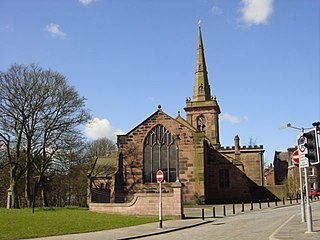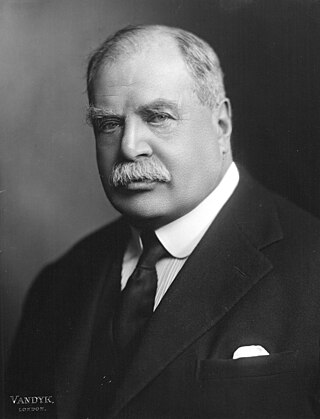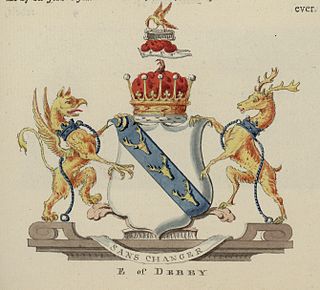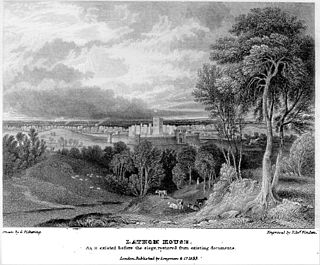
The Erfurt massacre was a school shooting that occurred on 26 April 2002 at the Gutenberg-Gymnasium, a secondary school in Erfurt, Germany. 19-year-old expelled student Robert Steinhäuser shot and killed 16 people, including 13 staff members, two students, and one police officer before committing suicide. One person was also wounded by a bullet fragment. According to students, he ignored them and aimed only for the teachers and administrators, although two students were unintentionally killed by shots fired through a locked door.

Prescot is a town and civil parish within the Metropolitan Borough of Knowsley in Merseyside, United Kingdom. Within the boundaries of the historic county of Lancashire, it lies about eight miles (13 km) to the east of Liverpool city centre. At the 2001 Census, the civil parish population was 11,184. The population of the larger Prescot East and West wards at the 2011 census totalled 14,139. Prescot marks the beginning of the A58 road which runs through to Wetherby, near Leeds in West Yorkshire. The town is served by Prescot railway station and Eccleston Park railway station in neighbouring Eccleston.

Edward Smith-Stanley, 13th Earl of Derby, KG, of Knowsley Hall in Lancashire, was a politician, peer, landowner, builder, farmer, art collector and naturalist. He was the patron of the writer Edward Lear.

Edward George Villiers Stanley, 17th Earl of Derby,, styled Mr Edward Stanley until 1886, then The Hon Edward Stanley and then Lord Stanley from 1893 to 1908, was a British soldier, Conservative politician, diplomat, and racehorse owner. He was twice Secretary of State for War and also served as British Ambassador to France.

On March 30, 1981, President of the United States Ronald Reagan was shot and wounded by John Hinckley Jr. in Washington, D.C., as he was returning to his limousine after a speaking engagement at the Washington Hilton. Hinckley believed the attack would impress actress Jodie Foster, with whom he had developed an erotomanic obsession.

Robert Emmett Harron was an American motion picture actor of the early silent film era. Although he acted in over 200 films, he is possibly best recalled for his roles in the D.W. Griffith directed films The Birth of a Nation (1915) and Intolerance (1916).

Knowsley Hall is a stately home near Liverpool in the Metropolitan Borough of Knowsley, Merseyside, England. It is the ancestral home of the Stanley family, the Earls of Derby. The hall is surrounded by 2,500 acres (10 km2) of parkland, which contains the Knowsley Safari Park. Though the hall is still owned by the Stanley family, it is no longer a family home, but is instead used for corporate events, conferences and weddings. Since 1953, it has been designated a Grade II* listed building,

Edward Richard William Stanley, 19th Earl of Derby, is a British hereditary peer and landowner.

"Who Shot Phil?" was a storyline of the BBC soap opera EastEnders which began on 1 March 2001 and climaxed on 5 April 2001.

The siege of Lathom House was a military confrontation between a Parliamentarian army and a Royalist stronghold in Lathom near Ormskirk in Lancashire, during the First English Civil War. The first siege lasted from late February to late May 1644, when the siege was lifted. The second siege took place a year later from July to December 1645. Lathom House was captured and slighted.

Martin "Moe" Snyder, commonly known as Moe the Gimp due to his lame left leg, was an American gangster from Chicago, active in the 1920s and 1930s.
"Twenty-One Guns" is the 267th episode of the American television series, ER. The episode aired on May 18, 2006 on NBC.

Stash House is a 2012 American action thriller film directed by Eduardo Rodríguez and starring Sean Faris, Briana Evigan, Dolph Lundgren, and Jon Huertas. The film is part of the After Dark Action films.

Hamlet Winstanley (1698–1756) was an English painter, engraver and art agent. As a painter, he was mainly active as a portraitist and copyist.

On November 11, 2011, Oscar Ramiro Ortega-Hernandez, an unemployed 21-year-old man, fired multiple shots at the White House using a semi-automatic rifle. At least seven bullets hit the second floor. Neither President Barack Obama nor First Lady Michelle Obama were home at the time; the president was not in Washington, D.C., having been on a trip abroad. However, the couple's youngest daughter, Sasha, and the first lady's mother, Marian Shields Robinson, were in the White House. No one was injured. It took four days for the Secret Service to realize that bullets had struck the White House. Michelle Obama learned of the shooting from an usher, then summoned Mark J. Sullivan, director of the Secret Service, to find out why the first family had not been informed.

On July 23, 2015, a mass shooting occurred at the Grand 16 movie theater in Lafayette, Louisiana, United States. John Russell Houser, 59, opened fire during a showing of the film Trainwreck, killing two people and injuring nine others before committing suicide.

On October 1, 2017, a mass shooting occurred when 64-year-old Stephen Paddock opened fire on the crowd attending the Route 91 Harvest music festival on the Las Vegas Strip in Nevada from his 32nd-floor suites in the Mandalay Bay hotel. He fired more than 1,000 bullets, killing 60 people and wounding at least 413. The ensuing panic brought the total number of injured to approximately 867. About an hour later, he was found dead in his room from a self-inflicted gunshot wound. The motive for the shooting is officially undetermined.

The Robb Elementary School shooting was a mass shooting that occurred on May 24, 2022, in Uvalde, Texas, United States, when 18-year-old Salvador Ramos, a former student at the school, fatally shot 19 students and two teachers, while 17 others were injured but survived. After shooting and severely wounding his grandmother at their home earlier that day, Ramos drove to and entered the school, remaining in an adjoining classroom for more than an hour before members of the United States Border Patrol Tactical Unit fatally shot him after bypassing numerous local and state officers who had been in the school's hallways for over an hour.
On 22 August 2022, Olivia Pratt-Korbel, a nine-year-old girl, was shot by a masked gunman in Liverpool, England, and was pronounced dead the same day at the city's Alder Hey Children's Hospital. The attack took place at the doorstep of Pratt-Korbel's family home in Dovecot; the intended target of the attack was a 35-year-old gang member who had criminal convictions for drug dealing and burglary. During the attack, Pratt-Korbel was with her mother. A shot by the gunman passed through her mother's wrist and Pratt-Korbel's chest.




















